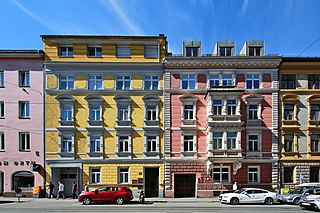
Innsbruck is the capital of Tyrol and the fifth-largest city in Austria. On the River Inn, at its junction with the Wipp Valley, which provides access to the Brenner Pass 30 km (19 mi) to the south, it had a population of 132,493 in 2018.

The history of Tyrol, a historical region in the middle alpine area of Central Europe, dates back to early human settlements at the end of the last glacier period, around 12,000 BC. Sedentary settlements of farmers and herders can be traced back to 5000 BC. Many of the main and side valleys were settled during the early Bronze Age, from 1800 to 1300 BC. From these settlements, two prominent cultures emerged: the Laugen-Melaun culture in the Bronze Age, and the Fritzens-Sanzeno culture in the Iron Age.

Andreas Hofer was a Tyrolean innkeeper and drover, who in 1809 became the leader of the Tyrolean Rebellion against the Napoleonic and Bavarian invasion during the War of the Fifth Coalition. He was subsequently captured and executed.
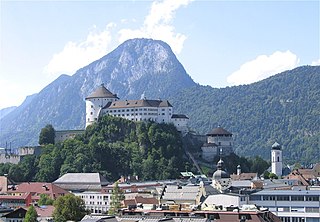
Kufstein is a town in the Austrian state of Tyrol, the administrative seat of Kufstein District. With a population of about 20,000 it is the second largest Tyrolean town after the state capital Innsbruck. The greatest landmark is Kufstein Fortress, first mentioned in the 13th century. The town was the place of origin of the Austrian noble family Kuefstein.

Bianca Maria Sforza was Queen of Germany and Empress of the Holy Roman Empire as the third spouse of Maximilian I. She was the eldest legitimate daughter of Duke Galeazzo Maria Sforza of Milan by his second wife, Bona of Savoy.

The Votivkirche is a neo-Gothic style church located on the Ringstraße in Vienna, Austria. Following the attempted assassination of Emperor Franz Joseph in 1853, the Emperor's brother Archduke Ferdinand Maximilian inaugurated a campaign to create a church to thank God for saving the Emperor's life. Funds for construction were solicited from throughout the Empire. The church was dedicated in 1879 on the silver anniversary of Emperor Franz Joseph and his wife Empress Elisabeth.
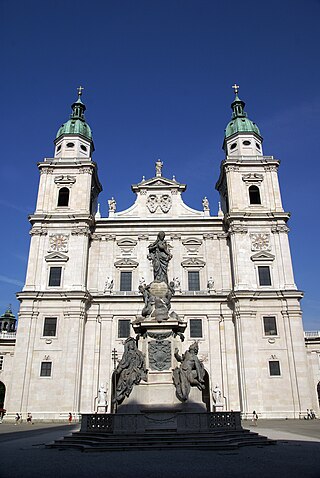
Salzburg Cathedral is the seventeenth-century Baroque cathedral of the Roman Catholic Archdiocese of Salzburg in the city of Salzburg, Austria, dedicated to Saint Rupert and Saint Vergilius. Saint Rupert founded the church in 774 on the remnants of a Roman town, and the cathedral was rebuilt in 1181 after a fire. In the seventeenth century, the cathedral was completely rebuilt in the Baroque style under Prince-Bishop Wolf Dietrich von Raitenau to its present appearance. Salzburg Cathedral still contains the baptismal font in which composer Wolfgang Amadeus Mozart was baptized.

The Augustinian Church in Vienna is a parish church located on Josefsplatz, next to the Hofburg, the winter palace of the Habsburg dynasty in Vienna. Originally built in the 14th century as the parish church of the imperial court of the Habsburgs, the harmonious Gothic interior was added in the 18th century. The official name of church and parish is St. Augustin, but it is locally called Augustinerkirche.
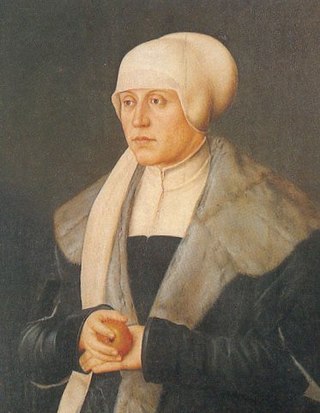
Kunigunde of Austria, a member of the House of Habsburg, was Duchess of Bavaria from 1487 to 1508, by her marriage to the Wittelsbach duke Albert IV.

The (Princely) County of Tyrol was an estate of the Holy Roman Empire established about 1140. After 1253, it was ruled by the House of Gorizia and from 1363 by the House of Habsburg. In 1804, the County of Tyrol, unified with the secularised prince-bishoprics of Trent and Brixen, became a crown land of the Austrian Empire. From 1867, it was a Cisleithanian crown land of Austria-Hungary.

Ambras Castle is a Renaissance castle and palace located in the hills above Innsbruck, Austria. Ambras Castle is 632 metres (2,073 ft) above sea level. Considered one of the most popular tourist attractions of the Tyrol, Ambras Castle was built in the 16th century on the spot of an earlier 10th-century castle, which became the seat of power for the Counts of Andechs. The cultural and historical importance of the castle is closely connected with Archduke Ferdinand II (1529–1595) and served as his family's residence from 1567 to 1595. Ferdinand was one of history's most prominent collectors of art. The princely sovereign of Tyrol, son of Emperor Ferdinand I, ordered that the medieval fortress at Ambras be turned into a Renaissance castle as a gift for his wife Philippine Welser. The cultured humanist from the House of Habsburg accommodated his world-famous collections in a museum: the collections, still in the Lower Castle built specifically for that museum's purpose, make Castle Ambras Innsbruck one of the oldest museums in the world.

Giovanni Ambrogio de Predis was an Italian Renaissance painter, illuminator and designer of coins active in Milan. Ambrogio gained a reputation as a portraitist, including as a painter of miniatures, at the court of Ludovico Sforza.

Stams is a municipality in Imst District, in the Austrian state of Tyrol. It is chiefly known for Cistercian Stams Abbey, founded in 1273 by Count Meinhard II of Gorizia-Tyrol and his wife.

The Hofkirche is a Gothic church located in the Altstadt section of Innsbruck, Austria. The church was built in 1553 by Emperor Ferdinand I (1503–1564) as a memorial to his grandfather Emperor Maximilian I (1459–1519), whose cenotaph within boasts a remarkable collection of German Renaissance sculpture. The church also contains the tomb of Andreas Hofer, Tyrol's national hero.

The Triumphal Arch is a 16th-century monumental woodcut print commissioned by the Holy Roman Emperor Maximilian I. The composite image was printed on 36 large sheets of paper from 195 separate wood blocks. At 295 × 357 centimetres (116 × 141 in), it is one of the largest prints ever produced and was intended to be pasted to walls in city halls or the palaces of princes. It is a part of a series of three huge prints created for Maximilian, the others being a Triumphal Procession which is led by a Large Triumphal Carriage ; only the Arch was completed in Maximilian's lifetime and distributed as propaganda, as he intended. Together, this series has been described by art historian Hyatt Mayor as "Maximilian's program of paper grandeur". They stand alongside two published biographical allegories in verse, the Theuerdank and Weisskunig, heavily illustrated with woodcuts.

Tratzberg Castle is a castle in Jenbach, Tyrol, Austria. Tratzberg Castle is located on a steep ridge above Jenbach in the Austrian part of Tyrol. It is an excellent example of palace architecture typical for the alpine parts of the Holy Roman Empire during the late Gothic and early Renaissance period. The castle was built in its present form in 1500 mostly by the brothers Veit-Jakob and Simon Tänzl. Today Tratzberg Castle is owned and inhabited by Count Ulrich Goëss-Enzenberg and his wife Katrin Goëss-Enzenberg. Tratzberg is also one of the best preserved castles in Austria, having many of its original furnishings and fittings.

The Hofgarten is a protected park located on the edge of the Altstadt section of Innsbruck, Austria. The park covers an area of 10 hectares, and borders on the Hofburg, the Kongresshaus, and the Tyrolean State Theatre.

Innsbruck Cathedral, also known as the Cathedral of St. James, is an eighteenth-century Baroque cathedral of the Roman Catholic Diocese of Innsbruck in the city of Innsbruck, Austria, dedicated to the apostle Saint James, son of Zebedee. Based on designs by the architect Johann Jakob Herkomer, the cathedral was built between 1717 and 1724 on the site of a twelfth-century Romanesque church. The interior is enclosed by three domed vaults spanning the nave, and a dome with lantern above the chancel. With its lavish Baroque interior, executed in part by the Asam brothers, St. James is considered among the most important Baroque buildings in the Tyrol.

HelblingHouse is a building located in the Old Town (Altstadt) section of Innsbruck, Austria, across from the Golden Roof at Herzog-Friedrich-Strasse 10. The original structure was built in the fifteenth century, but evolved significantly with new architectural styles in subsequent centuries.
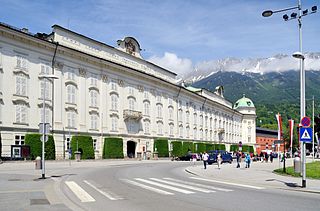
The Hofburg is a former Habsburg palace in Innsbruck, Austria, and considered one of the three most significant cultural buildings in the country, along with the Hofburg Palace and Schönbrunn Palace in Vienna. The Hofburg is the main building of a large residential complex once used by the Habsburgs that still includes the Noblewomen's Collegiate Foundation, the Silver Chapel, the Hofkirche containing Emperor Maximilian's cenotaph and the Schwarzen Mandern, the Theological University, the Tyrolean Folk Art Museum, Innsbruck Cathedral, the Congress, and the Hofgarten.


























